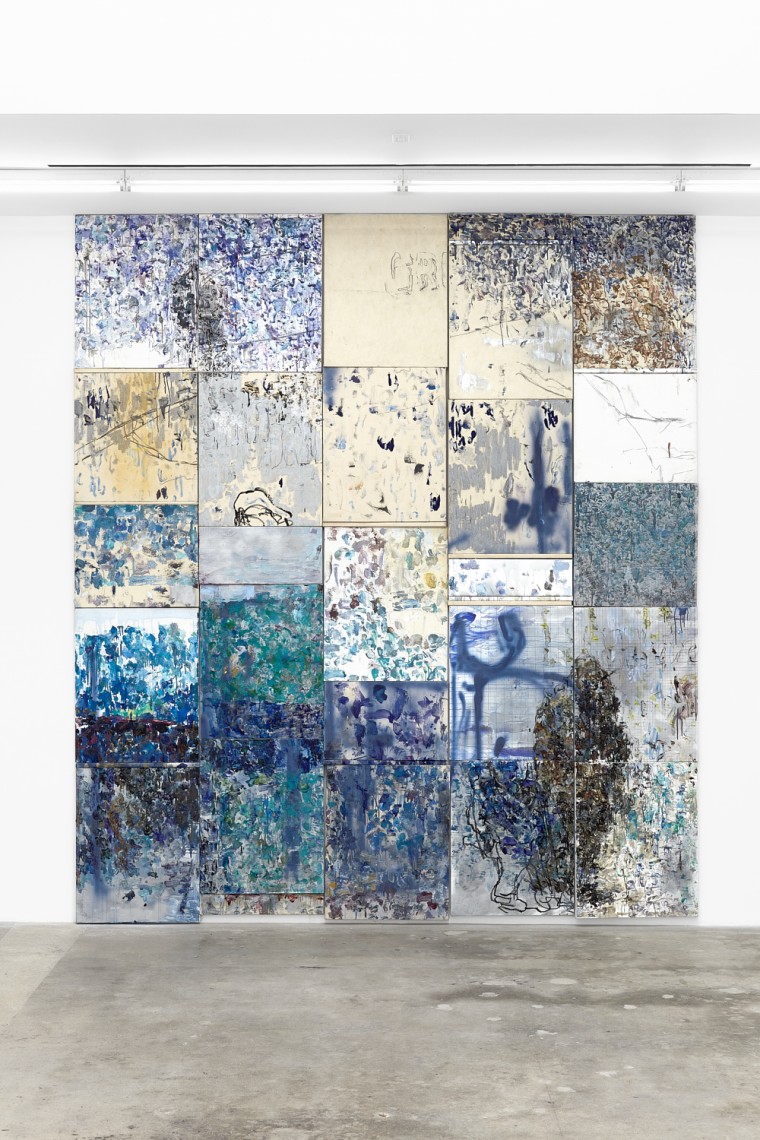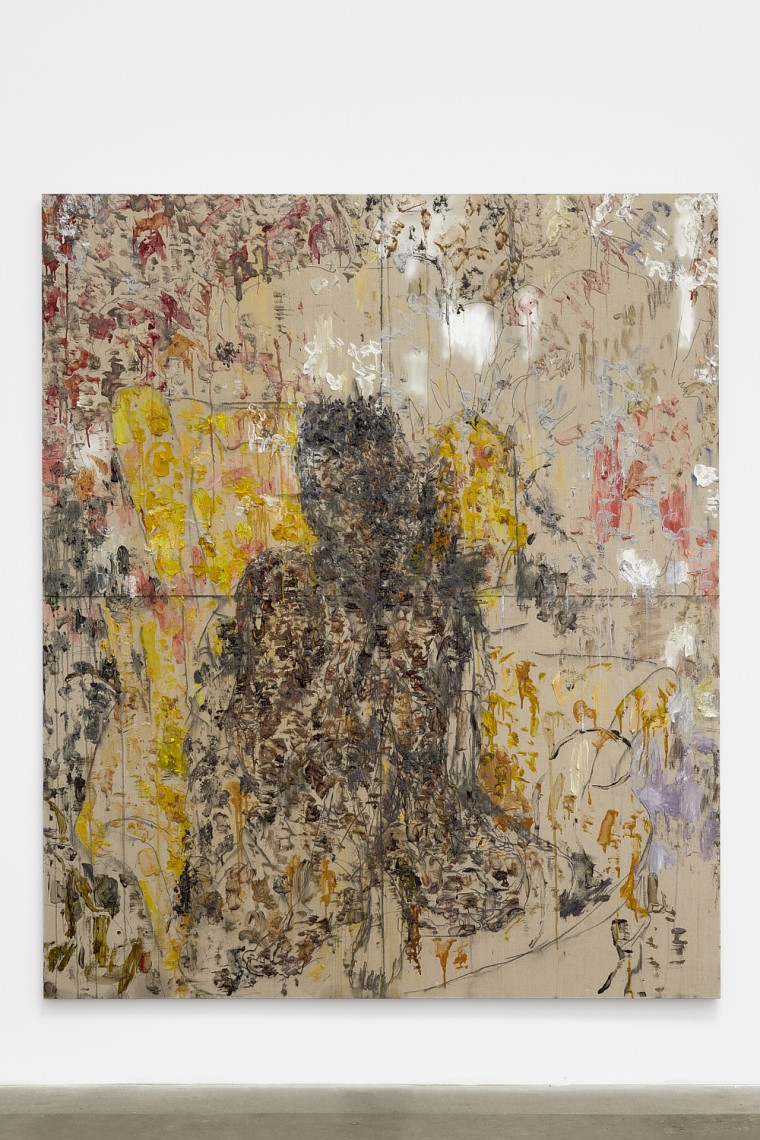
ANDY ROBERT: LAKOU: ONE TWO FIVE
Until FEBRUARY 17, 2018, Hanna Hoffman Gallery LA
Remembering Ken Kenneth P.Thompson, 2017.
A Painting as a Place / Andy Robert. LAKOU: One Two Five
When I first visited Andy Robert’s studio weeks ago, he was working on the paintings for Lakou: One Two Five, and his studio was overwhelmed with “the making.” Multiple samples of paint and pigments covered the floor in small paper containers. In front of me a fragmented grid of dispersed (at that moment) collaged-together canvases looked like the pieces of a puzzle. Also in the making were large-format canvases that leaned against the walls. Scattered across the floor were printed photographs of city signs and portraits of people from New York: Harlem, Flatbush, Nostrand, as well as other Caribbean neighborhoods in Brooklyn. Altogether, the elements created an idea of space and process that already belonged to the paintings. Even though the artist knew precisely where he wanted to go, the references and how to finish them remained uncertain. The artworks still needed to achieve the conceptual and material density present in the vocabulary Robert had been developing over the past years. Facing the canvases in front of me, I felt I was witnessing a language being formed in that moment.
Cross Country D, 2017.
All of these artworks had one thing in common, deconstructive layers operating both in time and space, inside and outside. In a sense, Robert’s paintings were acquiring the materiality of lakou – a Creole word used to designate a self-regulated type of property deeply ingrained in Haitian culture and able to encompass a variety of meanings and uses. A lakou, for example, may be a family courtyard inherited by generations, and shared by the relatives. This implies that one can belong to a specific lakou, which in turn connects you with your ancestors. Lakou land cannot be sold or transferred due to the association with religion and identity. It is also an economic unit and a self-regulated form of social organization that has been part of Haitian society for centuries. The history of the lakou intertwines the specificity of a place, its history and culture. It is the result of a colonial society, and the heritage of the Maroons and the Taíno people. Maroons were African descendant slaves that escaped from the plantations, hid in the woods, and formed autonomous settlements throughout the colonial Americas. A form of radical political and social reaction to enslavement, the Marronage spread out through the entire American continent and the islands.

Evans, 2017.
Andy Robert employs thick oil colors and strokes that do not cover the entire surface of the canvas. These layers are rooted in histori-cal and theoretical research and play out on the surface of the works in a tension between figurative painting and abstraction. Even though the topics related to Robert’s paintings are linked to his biography, his intentions are not expressive or emotional, but a reflection about how painting preserves its autonomy in a metaphysical way and links to the idea of place and inheritance through the relationship between the viewer and the work. This relation conflates a subjective and collective experience. It does not introduce the idea through the style of realism or a documentary form; rather the paintings are paradoxically both contextual and distant to a specific historical background. An uncertain temporality is tied up in the paintings, maybe in the same way a colonial history is the undercurrent where the Maroonage and the lakou coexist as a past and present form.

Anacaona, 2017.
In his paintings, the minimalistic phrase “You see what you see,” escapes its tautological and literalistic destiny. Instead, the works give back to the viewer the latency of a place through the grid, the color, the thickness, as well as gestural, deconstructive and indexical form. But they are still paintings. They do not pursue their extension in the gallery space as an installation or any idea of an expanded work. On the contrary, they defend the frame and the canvas as points of departure and end.

Police and Thieves, 2017.
Through the notion of the lakou and Marronage as preservation of culture and heritage pride, and by setting the Harlem street coordi-nates of “One, Two, Five” as the title of the show, Robert’s paintings pulse between historical contradictions of a colonial past and the possibility of a black metropolis: a city that is guided by economy, place and friction. In Robert’s work, symbols are simultaneously clear and veiled at the same time. On one painting a sign of a “Checks Cashed” business occupies the center of the composition. It calls to mind the massive numbers of underbanked people in America, and evokes the parallel economy and industry sustained by the labor force that, as described by the Marxist geographer David Harvey, fill the subway every day to make the city live. The same labor force use this economy to send money to Haiti, Mexico, and the rest of the former colonies. The paintings become the scenes where these forces appear as a substrate. A contemporary neon pop sign such as the “Checks Cashed” is forced into ambiguity without losing its identification. The sign is depicted as not only language, but as signifier of a place, an economy, and a history. Andy Robert transforms this background into painting, and painting into a material and conceptual medium, developing a language and a place that are built in the same instant of spectatorship, opening the possibility of re-inscribing the transcendental characteristics of the lakou in the present.
Amanda de la Garza
1010 N. HIGHLAND AVENUE LOS ANGELES, CA 90038 WWW.HANNAHHOFFMANGALLERY.COM +1 323 450 9106
